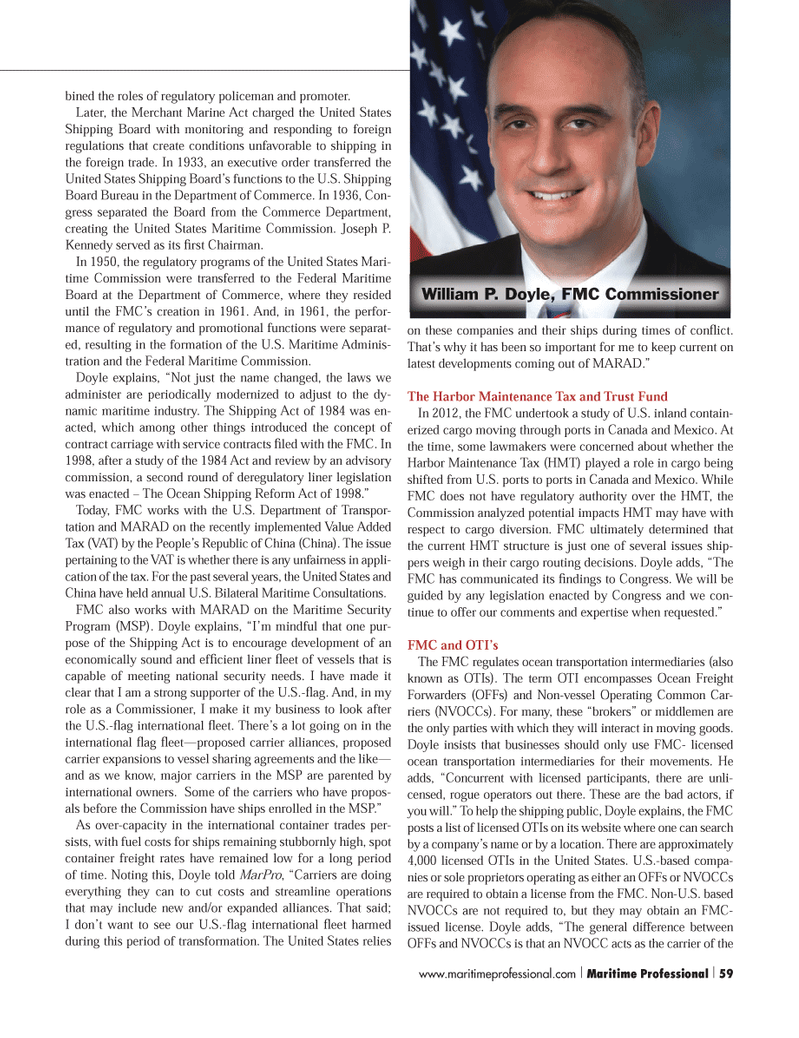
Page 59: of Maritime Logistics Professional Magazine (Q1 2014)
The Energy Edition: Exploration, Production & Transportation
Read this page in Pdf, Flash or Html5 edition of Q1 2014 Maritime Logistics Professional Magazine
bined the roles of regulatory policeman and promoter.
Later, the Merchant Marine Act charged the United States
Shipping Board with monitoring and responding to foreign regulations that create conditions unfavorable to shipping in the foreign trade. In 1933, an executive order transferred the
United States Shipping Board’s functions to the U.S. Shipping
Board Bureau in the Department of Commerce. In 1936, Con- gress separated the Board from the Commerce Department, creating the United States Maritime Commission. Joseph P.
Kennedy served as its fi rst Chairman.
In 1950, the regulatory programs of the United States Mari- time Commission were transferred to the Federal Maritime
Board at the Department of Commerce, where they resided until the FMC’s creation in 1961. And, in 1961, the perfor- mance of regulatory and promotional functions were separat- ed, resulting in the formation of the U.S. Maritime Adminis- tration and the Federal Maritime Commission.
Doyle explains, “Not just the name changed, the laws we administer are periodically modernized to adjust to the dy- namic maritime industry. The Shipping Act of 1984 was en- acted, which among other things introduced the concept of contract carriage with service contracts fi led with the FMC. In 1998, after a study of the 1984 Act and review by an advisory commission, a second round of deregulatory liner legislation was enacted – The Ocean Shipping Reform Act of 1998.”
Today, FMC works with the U.S. Department of Transpor- tation and MARAD on the recently implemented Value Added
Tax (VAT) by the People’s Republic of China (China). The issue pertaining to the VAT is whether there is any unfairness in appli- cation of the tax. For the past several years, the United States and
China have held annual U.S. Bilateral Maritime Consultations.
FMC also works with MARAD on the Maritime Security
Program (MSP). Doyle explains, “I’m mindful that one pur- pose of the Shipping Act is to encourage development of an economically sound and effi cient liner fl eet of vessels that is capable of meeting national security needs. I have made it clear that I am a strong supporter of the U.S.-fl ag. And, in my role as a Commissioner, I make it my business to look after the U.S.-fl ag international fl eet. There’s a lot going on in the international fl ag fl eet—proposed carrier alliances, proposed carrier expansions to vessel sharing agreements and the like— and as we know, major carriers in the MSP are parented by international owners. Some of the carriers who have propos- als before the Commission have ships enrolled in the MSP.”
As over-capacity in the international container trades per- sists, with fuel costs for ships remaining stubbornly high, spot container freight rates have remained low for a long period of time. Noting this, Doyle told MarPro, “Carriers are doing everything they can to cut costs and streamline operations that may include new and/or expanded alliances. That said;
I don’t want to see our U.S.-fl ag international fl eet harmed during this period of transformation. The United States relies on these companies and their ships during times of confl ict.
That’s why it has been so important for me to keep current on latest developments coming out of MARAD.”
The Harbor Maintenance Tax and Trust Fund
In 2012, the FMC undertook a study of U.S. inland contain- erized cargo moving through ports in Canada and Mexico. At the time, some lawmakers were concerned about whether the
Harbor Maintenance Tax (HMT) played a role in cargo being shifted from U.S. ports to ports in Canada and Mexico. While
FMC does not have regulatory authority over the HMT, the
Commission analyzed potential impacts HMT may have with respect to cargo diversion. FMC ultimately determined that the current HMT structure is just one of several issues ship- pers weigh in their cargo routing decisions. Doyle adds, “The
FMC has communicated its fi ndings to Congress. We will be guided by any legislation enacted by Congress and we con- tinue to offer our comments and expertise when requested.”
FMC and OTI’s
The FMC regulates ocean transportation intermediaries (also known as OTIs). The term OTI encompasses Ocean Freight
Forwarders (OFFs) and Non-vessel Operating Common Car- riers (NVOCCs). For many, these “brokers” or middlemen are the only parties with which they will interact in moving goods.
Doyle insists that businesses should only use FMC- licensed ocean transportation intermediaries for their movements. He adds, “Concurrent with licensed participants, there are unli- censed, rogue operators out there. These are the bad actors, if you will.” To help the shipping public, Doyle explains, the FMC posts a list of licensed OTIs on its website where one can search by a company’s name or by a location. There are approximately 4,000 licensed OTIs in the United States. U.S.-based compa- nies or sole proprietors operating as either an OFFs or NVOCCs are required to obtain a license from the FMC. Non-U.S. based
NVOCCs are not required to, but they may obtain an FMC- issued license. Doyle adds, “The general difference between
OFFs and NVOCCs is that an NVOCC acts as the carrier of the
William P. Doyle, FMC Commissioner www.maritimeprofessional.com | Maritime Professional | 59
MP Q1 2014 50-63.indd 59 2/27/2014 11:48:09 AM

 58
58

 60
60
